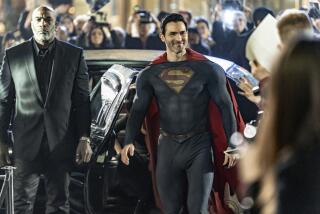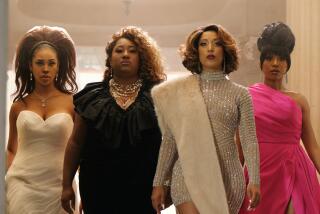A Dose of New ‘Life’ for KCET : Television: The station’s new current affairs series puts fresh eyes on Southern California with a brash, clashing panel and minidocumentaries.
At last, a sleaze-free 7:30 p.m. weekday alternative to “Hard Copy” and “A Current Affair.”
The welcome newcomer is “Life & Times,” the current affair of KCET Channel 28. It’s a promising half-hour series that may have the fresh eyes through which to observe Southern California and its inhabitants in interesting new ways. They aren’t the swollen cynical eyes of local TV news, nor ones whose view is softened or distorted by rose-colored lenses.
On Mondays and Fridays, “Life & Times” is a studio-bound show with talking heads. Tuesdays, Wednesdays and Thursdays bring minidocs that are a little longer (and doughier) than the typical story on “60 Minutes” or “20/20.”
Although KCET has had some occasional streaks of glory in recent years, its last five-day-a-week local public-affairs program came when Ronald Reagan was still unfurling his first term in the White House, NBC was airing “Here’s Boomer” and ABC’s “That’s Incredible” was still one of the hotter tickets in prime time. For a public station with the size and visibility of KCET, that’s incredible.
Somewhat less so is tonight’s debut of Hugh Hewitt, Patt Morrison and John Ochoa as the host trio for the in-studio segments on Monday (on tape) and Fridays (live). Hewitt has a Saturday-morning show on KFI-AM (640), Morrison is a reporter for the Los Angeles Times and Ochoa is former director for the Greater Los Angeles Partnership for the Homeless.
As far as TV goes, they’re new faces, and you have to like the thoughtfulness, brash vitality and often-clashing perspectives they bring to the medium. Not as appealing is the limited way they are deployed in this opening program that examines the Los Angeles Country Transportation Commission’s controversial decision to award a Japanese firm a $121.8-million contract to build the Metro Green Line’s driverless cars.
The combative guests--commission chairman Ray Grabinski and public transportation advocate Catherine O’Neill--deliver a spirited segment, but one that isn’t precise enough in defining the issues and assumes too much knowledge on the part of viewers.
Moreover, there’s not enough of Hewitt, Morrison and Ochoa, talking heads whose talk is worth hearing. They’re the tone setters. With their distinctive views, biting comments and appealing chemistry, they have the potential to give these twice-weekly studio sessions a special attractiveness. They should be the reason viewers tune in.
Tonight, however, they’re not given enough time for the playful, free-flowing interchanges they displayed in some earlier, unaired, unofficial test runs. Plus, in their debut, they do their own imitation of the Green Line. In the eternal TV quest for “high energy,” they’re now speeding--often talking too fast--as if someone were goosing them from behind with a cattle prod.
The music is sweeter Tuesday, when “Life & Times” briefly glimpses the intersecting lives of three very different mariachi artists in a poignant piece by Pedro Pablo Celedon that celebrates mariachi while distinguishing the men from the music.
One is successful band leader Jose Hernandez. Another is Eriberto Vargas, a 19-year-old violinist fresh from Mexico. The third is “The Needle,” a drug-woozy, booze-dazed derelict whose life Hernandez is trying to salvage.
“Don’t hurt yourself like that,” Hernandez tells his semi-coherent friend when he runs into him in Boyle Heights, where the band leader has gone to recruit musicians. He had hoped “The Needle” would be one of them, but the once-accomplished horn player is in shambles. The next day Hernandez gives “The Needle” his own trumpet for good luck.
There is a gap in the narrative, when “The Needle” is suddenly back on the street without explanation after having been shown taken away by police. More significantly, though, this is an acutely bittersweet slice of Los Angeles, the sorrow embodied by a dysfunctional former mariachi great contrasted with the optimism of Hernandez and Vargas.
“Music will save him,” Hernandez says about “The Needle.” Maybe not.
Less successful are segments produced by Arthur Dong for Wednesday and Thursday. The first enlists outspoken L.A. social critics Joel Kotkin and Mike Davis to present two dramatically different sides of California’s immigrant odyssey.
Kotkin introduces three stunning success stories: Latina fashion designer Ophelia Montejano; Soviet emigre Anne Volokh, publisher of “Movieline” magazine; and Pakistani Safi Qureshey, co-owner of Irvine-based AST Research. But, in the minuscule time allotted them, they are unable to convey a sense of what lifted them above the masses.
Wednesday’s segment achieves a bit more with Davis’ negative slant on the immigrant dream, which includes a specific detailing of some grim economic and social realities that are symbolized by a family center operated out of the Dolores Mission.
This first three-day batch of documentaries ends on a last-but-least note Thursday with a profile of Asian-American performance artists that begins interestingly but is allowed to meander and become static.
In any event, what you see this week is not what you will always get. KCET says it has money in its present budget to produce only 16 weeks worth of documentary segments, after which they will be repeated. Goodby freshness, hello reruns.
But, one hopes, not another unfulfilled chapter in the tumultuous life and times of KCET.
More to Read
The complete guide to home viewing
Get Screen Gab for everything about the TV shows and streaming movies everyone’s talking about.
You may occasionally receive promotional content from the Los Angeles Times.






